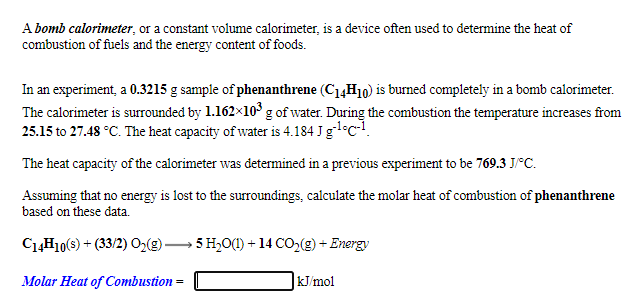A bomb calorimeter, or a constant volume calorimeter, is a device often used to determine the heat of combustion of fuels and the energy content of foods. In an experiment, a 0.3215 g sample of phenanthrene (C1,H10) is buned completely in a bomb calorimeter. The calorimeter is surrounded by 1.162×10 g of water. During the combustion the temperature increases from 25.15 to 27.48 °C. The heat capacity of water is 4.184 J gl°c-!. The heat capacity of the calorimeter was determined in a previous experiment to be 769.3 J°C. Assuming that no energy is lost to the surroundings, calculate the molar heat of combustion of phenanthrene based on these data. C1„H10(s) + (33/2) O,(2) 5 H2O(1) + 14 CO,(g) + Energy Molar Heat of Combustion |kJ/mol
A bomb calorimeter, or a constant volume calorimeter, is a device often used to determine the heat of combustion of fuels and the energy content of foods. In an experiment, a 0.3215 g sample of phenanthrene (C1,H10) is buned completely in a bomb calorimeter. The calorimeter is surrounded by 1.162×10 g of water. During the combustion the temperature increases from 25.15 to 27.48 °C. The heat capacity of water is 4.184 J gl°c-!. The heat capacity of the calorimeter was determined in a previous experiment to be 769.3 J°C. Assuming that no energy is lost to the surroundings, calculate the molar heat of combustion of phenanthrene based on these data. C1„H10(s) + (33/2) O,(2) 5 H2O(1) + 14 CO,(g) + Energy Molar Heat of Combustion |kJ/mol
General Chemistry - Standalone book (MindTap Course List)
11th Edition
ISBN:9781305580343
Author:Steven D. Gammon, Ebbing, Darrell Ebbing, Steven D., Darrell; Gammon, Darrell Ebbing; Steven D. Gammon, Darrell D.; Gammon, Ebbing; Steven D. Gammon; Darrell
Publisher:Steven D. Gammon, Ebbing, Darrell Ebbing, Steven D., Darrell; Gammon, Darrell Ebbing; Steven D. Gammon, Darrell D.; Gammon, Ebbing; Steven D. Gammon; Darrell
Chapter6: Thermochemisty
Section: Chapter Questions
Problem 6.109QP: A 21.3-mL sample of 0.977 M NaOH is mixed with 29.5 mL of 0.918 M HCl in a coffee-cup calorimeter...
Related questions
Question

Transcribed Image Text:A bomb calorimeter, or a constant volume calorimeter, is a device often used to determine the heat of
combustion of fuels and the energy content of foods.
In an experiment, a 0.3215 g sample of phenanthrene (C14H10) is burned completely in a bomb calorimeter.
The calorimeter is surrounded by 1.162×10 g of water. During the combustion the temperature increases from
25.15 to 27.48 °C. The heat capacity of water is 4.184 J glc-!.
The heat capacity of the calorimeter was determined in a previous experiment to be 769.3 J/°C.
Assuming that no energy is lost to the surroundings, calculate the molar heat of combustion of phenanthrene
based on these data.
C14H10(s) + (33/2) O,(g) –
→ 5 H,O(1) + 14 CO2(g) + Energy
Molar Heat of Combustion =
kJ/mol
Expert Solution
This question has been solved!
Explore an expertly crafted, step-by-step solution for a thorough understanding of key concepts.
This is a popular solution!
Trending now
This is a popular solution!
Step by step
Solved in 2 steps with 2 images

Knowledge Booster
Learn more about
Need a deep-dive on the concept behind this application? Look no further. Learn more about this topic, chemistry and related others by exploring similar questions and additional content below.Recommended textbooks for you

General Chemistry - Standalone book (MindTap Cour…
Chemistry
ISBN:
9781305580343
Author:
Steven D. Gammon, Ebbing, Darrell Ebbing, Steven D., Darrell; Gammon, Darrell Ebbing; Steven D. Gammon, Darrell D.; Gammon, Ebbing; Steven D. Gammon; Darrell
Publisher:
Cengage Learning

Chemistry: Principles and Reactions
Chemistry
ISBN:
9781305079373
Author:
William L. Masterton, Cecile N. Hurley
Publisher:
Cengage Learning

Chemistry
Chemistry
ISBN:
9781305957404
Author:
Steven S. Zumdahl, Susan A. Zumdahl, Donald J. DeCoste
Publisher:
Cengage Learning

General Chemistry - Standalone book (MindTap Cour…
Chemistry
ISBN:
9781305580343
Author:
Steven D. Gammon, Ebbing, Darrell Ebbing, Steven D., Darrell; Gammon, Darrell Ebbing; Steven D. Gammon, Darrell D.; Gammon, Ebbing; Steven D. Gammon; Darrell
Publisher:
Cengage Learning

Chemistry: Principles and Reactions
Chemistry
ISBN:
9781305079373
Author:
William L. Masterton, Cecile N. Hurley
Publisher:
Cengage Learning

Chemistry
Chemistry
ISBN:
9781305957404
Author:
Steven S. Zumdahl, Susan A. Zumdahl, Donald J. DeCoste
Publisher:
Cengage Learning


Chemistry: An Atoms First Approach
Chemistry
ISBN:
9781305079243
Author:
Steven S. Zumdahl, Susan A. Zumdahl
Publisher:
Cengage Learning

Chemistry by OpenStax (2015-05-04)
Chemistry
ISBN:
9781938168390
Author:
Klaus Theopold, Richard H Langley, Paul Flowers, William R. Robinson, Mark Blaser
Publisher:
OpenStax